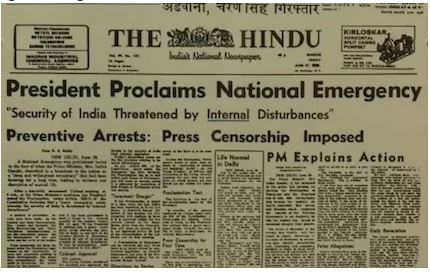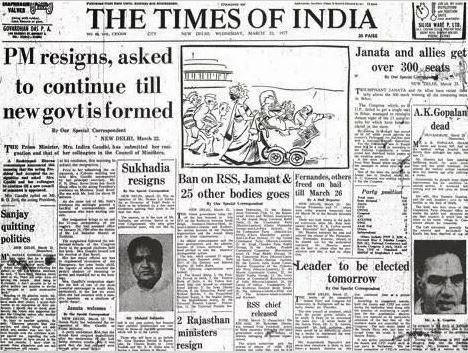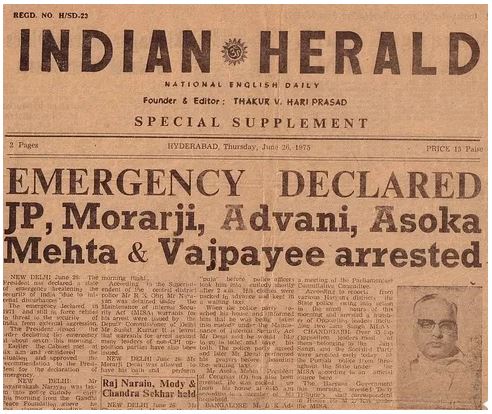Mystery Behind The 1975 National Emergency


April 28th 1976 is remembered as a black day in the history of Indian democracy. The very foundations of democracy were murdered on this day when the Supreme Court pronounced its judgment in A.D.M Jabalpur Vs Shukla .The decision of Supreme Court in A.D.M.Jabalpuer Vs shukla had greatly disappointed the Indians who loved the pledges of justice and liberty incorporated in the preamble of our constitution.
FACTS OF THE CASE
The germs of this case were to be found in the election of Mrs Indira Gandhi (the then prime minster of India) which had been held to be invalid by the Allahabad High Court. In her desire to stick to the chair of prime minster she chose to declare a national emergency on 25th June 1975 on the ground of ‘internal threat’ to the security of India. As a result of the emergency censorship was imposed on the press on 25th June 1975 itself. On 5th August 1975, Maintenance of Internal Security Act (MISA) was approved by the parliament and a number of opposition leaders were detained under this law. Any person who was considered to be a political threat or who could raise the voice of opposition was detained without trial under the MISA. According to Amnesty International, 1, 40,000 persons were arrested without trial during the emergency period. Many of the detained persons challenged their arrest through writs before the High Courts under Article 226 of the constitution of India. As a result of these writs the state governments in many of the High court’s raised the issue that , whether such writs were maintainable on the ground that under the presidential order declaring emergency the right to file such writ was taken away. All the High court’s declared that despite the suspension of fundamental right of a detained person , he could show that his detention was not in accordance with the law under which he was detained or that there was a mistake of identity.
The government being unsatisfied with this decision appealed to the Supreme Court and thus the most controversial case of A.D.M Jabalpur Vs Shukla came before the Supreme Court for hearing.
The then attorney general Niren De contended that the writ petitions would necessarily be dismissed since the right to move any court had been suspended and the detenue had no locus standi.
ISSUE
The main issue before the Supreme Court in this case was:-
Whether the high courts can entertain a writ of habeas corpus filed by a person challenging his detention, during the emergency period?
DECISION OF SUPREME COURT
“In view of the presidential order dated 27th June 1975 no person has any locus standi to move any writ petition under Article 226 before a high court for habeas corpus or any other writ or order or direction to challenge the legality of an order of detention on the ground that the order is not under or in compliance with the Act or is illegal or is vitiated by mala fides factual or legal or is based on extraneous grounds”.
This was the judgment delivered by four senior, most judges of the Supreme Court including chief justice A.N.Ray. The dissenting judgment was that of justice H.R.Khanna. His contentions were opposed to that of the majority judgment. Justice Khanna made a significant quote in his judgment which runs as follows:-
“As observed by C.J, Huges , judges were not there simply to decide cases , but to decide them as they think they should be decided , and while it may be regrettable that they cannot always agree , it is better that their independence should be maintained and recognized than that unanimity should be secured through its sacrifice. A dissent in a court of last resort, to use his words, is an appeal to the brooding spirit of the law, to the intelligence of a future day, when a later decision may possibly correct the error into which the dissenting judge believes the court to have been betrayed”.

CRITICAL ANALYSIS
The chief reason behind the filing of this writ petition was the political unrest during that period. Opponents had long made allegations that the congress party had taken recourse to electoral frauds to win the 1971 election. Cases of election fraud and misuse of state machinery for election purposes were lodged in the Allahabad High Court against Indira Gandhi by Raj Narain who had been defeated in the parliamentary election by Indira Gandhi. The Allahabad High Court in its judgment declared Indira Gandhi’s election as void and also unseated her from the Lok Sabha. This decision in course of time became the primary reason for the imposition of the 1975 emergency.
On 26th sept. 1975, the 39th amendment to the constitution was made so as to place the election of prime minster beyond the judicial scrutiny. This was an intelligent step by Indira Gandhi to safeguard her seat.
A close study of the facts behind the filing of this writ petition reveals that it was in fact a case for assertion of political powers by one party over the other.
Further during 1975, another National emergency was also in operation on the ground of war with Pakistan. But before the imposition of national emergency on 1975 an amendment was made and a new provision was added in the constitution which provided for imposition of more than one national emergency under Article 352 at the same time. This was done to overcome any legal difficulty which may arise from the simultaneous operation of two national emergencies at the same time. This was in fact another intelligent step by Mrs Indira Gandhi to legalize the imposition of 1975 emergency.
As a matter of fact it is evident that the majority judgment of Supreme Court in A.D.M. Jabalpur Vs Shukla is to a great extent influenced by the political circumstances prevailing at that time. The supreme court even refused to follow the ruling in Makhan Singh Vs state of Punjab (1964) wherein the supreme court had pointed out that if a detenue challenged his detention on the ground that it violated statutory provision or the detention is vitiated by mala fides the challenge could not be barred because of the presidential order under Article 359(1),
However, the lone dissenting voice of justice Khanna was paid due respect in the year 1978 when the constitution 44th amendment Act was passed. Justice Khanna had paid the price for his dissent .He was supposed to be the next chief justice of India but unfortunately he had to resign before he could become the chief justice of India.
Before the 44th amendment the national emergency provision under Article 352(1) was as follows:- ‘the president can proclaim emergency when he is satisfied that a grave emergency exists whereby the security of India or any part of the territory thereof is threatened by (a) war; or(b) external aggression; or (c) internal disturbances
The words “internal disturbances” was in fact responsible for the successful imposition of the 1975 emergency. The words “internal disturbance” is a vague one and it is difficult to ascertain the situations covered under this words. However the 44th amendment to the constitution has substituted the words “armed rebellion” for the words “internal disturbances” and thereby narrowed the scope of emergency situations.
The constitution 44th amendment Act has a great significance in the Indian legal history. It has made the proclamation of emergency under Article 352(1) so complex that after 1975 no emergency has been proclaimed till today under Article 352(1). The 44th amendment has placed a number of significant safeguards to check the misuse of Article 352(1) in future.
Thus in conclusion it is clear that the 1975 national emergency was a pre planned drama of the Indira Gandhi govt. in order to secure certain political objectives.
You May Be Interested IN